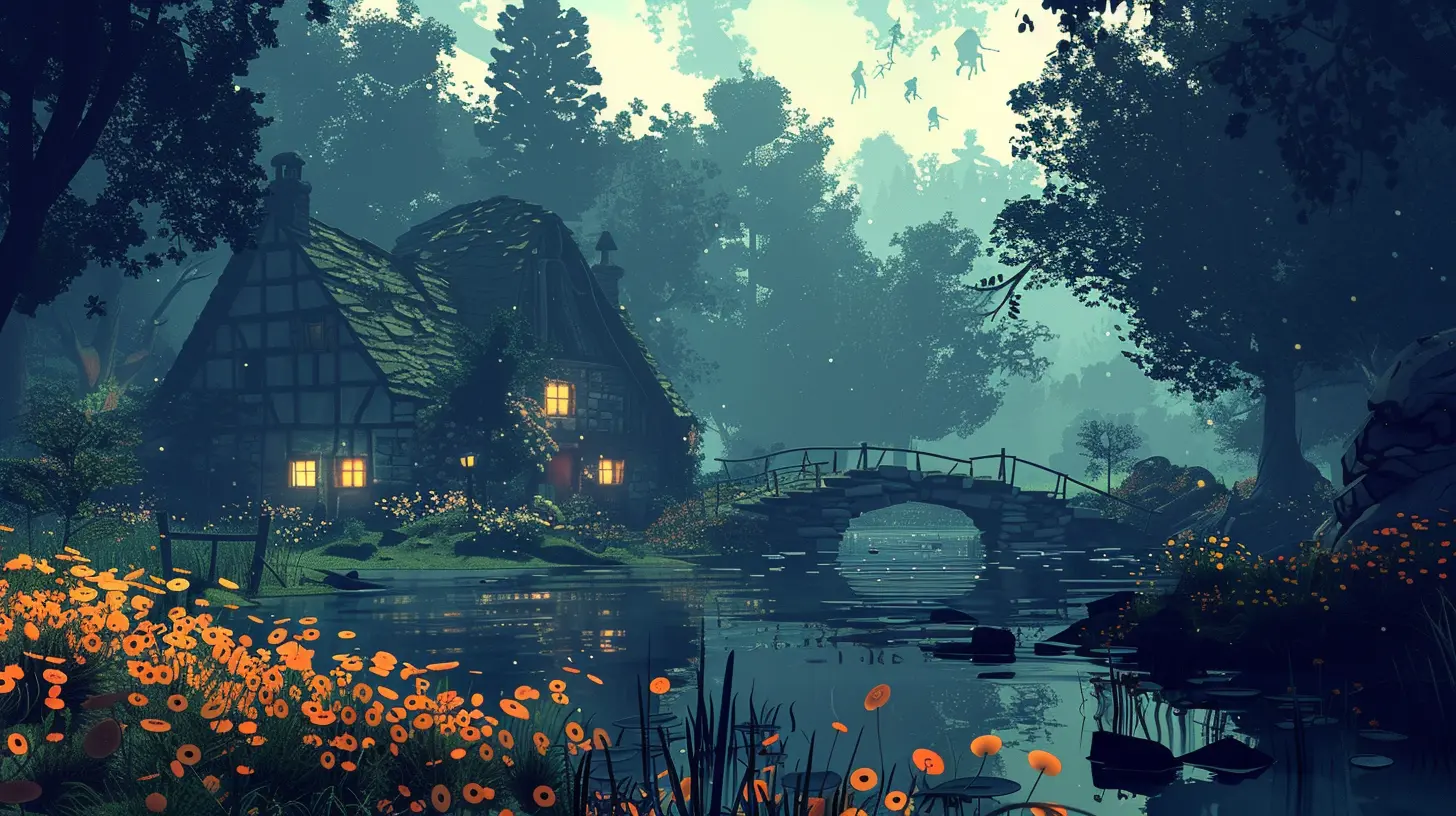Interactive Storytelling for Beginners: A Guide to Crafting Engaging Plots
14 October 2025
So, you’ve got a killer imagination, a love for games, and a deep fascination with storytelling. Maybe you’ve played a few narrative-driven games, and now you’re itching to create your own? Awesome! Because today, we’re going to dive into interactive storytelling — and I promise, it’s way less scary than it sounds.
Crafting engaging plots for interactive stories is more of an art than science. It’s like hosting a party where you want everyone to have a great time, but you can't force them to dance. You give them the space, set the mood, and let them choose their moves. This is about giving your players the freedom to explore a world of your making while still feeling the thrill of a well-told tale.
Let’s break it down step-by-step, plot twist by plot twist.
📜 What is Interactive Storytelling Anyway?
Interactive storytelling is storytelling… with a twist. Instead of a fixed story from point A to point Z, you’re building a dynamic narrative world where players make choices that shape the outcome. Think of games like Life is Strange, The Walking Dead, or Detroit: Become Human — the player isn’t just along for the ride; they’re the co-pilot.It’s not just about plot. It’s about agency. Your player isn't watching a movie. They’re living it. And that’s where the magic happens.
🎯 Why Storytelling Matters in Games
Sure, stunning graphics and tight gameplay are important. But ever notice how people gush about the emotional impact of a game — not just the controls?Story is how players connect. It’s how they remember your game. It’s what makes them care whether that NPC lives or dies (looking at you, Telltale Games). A well-crafted story makes everything else in your game matter more.
Even simple games benefit from a strong narrative. Just a sprinkle of context can transform a puzzle or platformer into an unforgettable adventure.
🧠 The Mindset of a Game Storyteller
Before we get to the nuts and bolts, let’s talk mindset.Traditional storytelling is like writing a book. You’re the god of your universe. Every word is yours. Interactive storytelling? You’ve got to be okay with letting go. You're more like a dungeon master in Dungeons & Dragons — setting the scene, creating compelling challenges, reacting to what the players do.
It’s a collaborative dance between you and the player. And you’ve gotta be ready to pivot. That’s what makes it exciting — and, honestly, way more fun.
🪜 Step 1: Start With the Big Picture (Then Zoom In)
Before you write a single line of dialogue, ask yourself:- What’s the core of my story?
- Who’s the player?
- What's the world like?
- What themes do I want to explore?
You don’t need to flesh out every street corner just yet. Start with a strong foundation. Think of it like building a tree: Your main story is the trunk, and all the choices and branches grow from there.
Example:
Let’s say you want to tell a story about a detective in a city plagued by supernatural crimes. That’s your trunk. From there, you’ll grow branches: Do they solve the case or get caught in the conspiracy? Do they become tainted by the magic or rise above it?Boom — now you’ve got flexibility and structure.
🧩 Step 2: Create Meaningful Choices
If your story is interactive, then choices are the engine that drives it. But don’t confuse quantity with quality.A good choice does one of three things:
1. Reveals something about the character (or player).
2. Moves the story forward in a different direction.
3. Changes how the world reacts to the player.
Avoid the classic “illusion of choice” pitfall — where all paths lead to the same place. That’s like giving someone a restaurant menu where every dish tastes the same. Players want their decisions to matter.
💡 Pro Tip: Even small differences in dialogue or consequences can make a choice feel real. You don’t need 100 endings. Just make each path feel personal.
🧱 Step 3: Build a Solid Structure
Interactive doesn’t mean chaotic.You’ll still need structure — a beginning, middle, and end — but with flexibility inside those parts.
Here are a few popular structures:
🔁 Branching Narrative
Each choice sprouts into different story paths. It’s the most well-known structure but also the most complex. The more branches, the more work.🎯 Hub-and-Spoke
Players return to a central point after exploring different paths (think of Mass Effect-style missions). It gives players freedom while keeping the plot on track.🧬 Twine-Style Webs
Think of it like a spiderweb. Players move from one node (point) to another, with multiple paths leading to the same outcome. This is great for balancing player freedom with narrative control.Pick the one that suits your story (and bandwidth). You don't want to get halfway through designing a 200-branch epic and realize you’ve bitten off more than you can chew.
🧍♂️ Step 4: Create Relatable Characters
Plot gets your players going. Characters make them stay.Your protagonist doesn’t have to be perfect — in fact, flaws make them more relatable. Let players shape them or reveal them through dialogue options and actions.
As for side characters? Make them feel real. Give them quirks, goals, and values. When NPCs feel like people, not plot devices, the story naturally becomes more immersive.
💬 Dialogue is key. Let it reveal personality and choice. Think less giant exposition dump and more character-driven moments.
🌍 Step 5: Build Your World With Purpose
You don’t need to go full Tolkien and create entire languages. But your world should feel alive.Ask yourself:
- What kind of society is this?
- Who’s in power?
- What tensions exist beneath the surface?
- What history shaped this world?
Every piece of lore should serve the story. Don’t just stuff your game with background because it sounds cool. Make sure it influences what the player sees, encounters, and decides.
🧪 Step 6: Playtest Like Crazy
Here’s the truth bomb: What you think works… might not. That clever twist? That deep dialogue tree? Players might blow past it. Or worse, not understand it.That’s where playtesting comes in.
Watch how players interact with your story. Don’t explain. Just observe. Are they engaged? Confused? Bored?
Feedback is gold. Use it to smooth out pacing, clarify decision points, and strengthen character arcs. The more you test, the tighter your narrative becomes.
⚙️ Step 7: Pick Your Tools
You don’t need to be a coder to get started with interactive storytelling. There are some amazing tools that do the heavy lifting for you:- Twine – Great for branching stories and prototypes
- Ink by Inkle – Lightweight scripting for flexible narratives
- Ren’Py – Perfect for visual novel-style stories
- ChoiceScript – Built for choice-based, text-heavy stories
Each tool has its strengths. Try a few. Find your best fit.
🧠 Bonus Tips to Really Nail It
🔎 Detail Matters (But Don’t Overload It)
Instead of describing everything, zoom in on emotionally charged moments. A single line of dialogue or a unique object can say more than a whole paragraph of fluff.📈 Keep Tension Rising
Whether it’s emotional stakes, moral dilemmas, or physical danger, something should always be at risk. Keep your players leaning in.🤝 Let Players Be Themselves
Offer responses and choices that reflect different types of players — the hero, the rebel, the diplomat. Let them roleplay.🌀 Embrace Replayability
Make your game worth playing again. Different endings, hidden paths, character arcs. Give players a reason to come back and explore the "what ifs."🎮 A Final Word: It's Your Story, But Not Just Yours
Interactive storytelling is a delicate balance between authorship and player freedom. It's your world — but they’re living in it. Don’t stress about making it perfect. Just make it meaningful. Connect with your audience. Give them space to explore, feel, and maybe even cry a little.You’re not just a writer anymore. You’re a world-builder, an experience crafter, a narrative architect. Get in there. Start small. Grow big.
And most importantly — have fun. Because if you’re loving the journey, chances are your players will too.
💬 Ready to Start?
Your story is waiting for you. Grab your keyboard, take a deep breath, and write that first choice. Adventure awaits — and you’re the one who gets to design it.all images in this post were generated using AI tools
Category:
Interactive StorytellingAuthor:

Lucy Ross
Discussion
rate this article
1 comments
Desiree Benton
Oh sure, because who doesn’t want to spend countless hours crafting the perfect plot when we can just binge-watch Netflix instead? But hey, if you’re into creating imaginary worlds, this guide might just be your ticket!
October 14, 2025 at 2:53 PM

Lucy Ross
Absolutely! While binge-watching is fun, creating your own worlds can be just as rewarding. Give it a try!


